Abstract
1. A single climbing fibre makes an extraordinarily extensive synaptic contact with the dendrites of a Purkinje cell. Investigation of this synaptic mechanism in the cerebellum of the cat has been based on the discovery by Szentagothai & Rajkovits (1959) that the climbing fibres have their cells of origin in the contralateral inferior olive.
2. Stimulation in the accessory olive selectively excites fibres that have a powerful synaptic excitatory action on Purkinje cells in the contralateral vermis, evoking a repetitive spike discharge of 5-7 msec duration. Almost invariably this response had an all-or-nothing character. In every respect it corresponds with the synaptic action that is to be expected from climbing fibres.
3. Intracellular recording from Purkinje cells reveals that this climbing fibre stimulation evokes a large unitary depolarization with an initial spike and later partial spike responses superimposed on a sustained depolarization.
4. Typical climbing fibre responses can be excited, but in a much less selective manner, by stimulation of the olive-cerebellar pathway in the region of the fastigial nucleus, there being often a preceding antidromic spike potential of the Purkinje cell under observation.
5. Impaled Purkinje cells rapidly deteriorate with loss of all spike discharge, the climbing fibre response being then reduced to an excitatory post-synaptic potential. This potential shows that stimulation of the inferior olive may evoke two or more discharges at about 2 msec intervals in the same climbing fibre. The complexity of neuronal connexions in the inferior olive is also indicated by the considerable latency range in responses.
6. A further complication is that, with stimulation in the region of the fastigial nucleus, the initial direct climbing fibre response is often followed by a reflex discharge, presumably from the inferior olive, which resembles the responses produced by inferior olive stimulation in being often repetitive.
7. Typical climbing fibre responses have been evoked by peripheral nerve stimulation and frequently occur spontaneously.
8. An account is given of the way in which the responses evoked by climbing fibres in the individual Purkinje cells can account for the potential fields that an inferior olive stimulus evokes on the surface and through the depth of the cerebellar cortex.
9. By the application of currents through the recording intracellular electrode it has been possible to effect large changes in the excitatory post-synaptic potential produced by a climbing fibre, it being diminished and even reversed with depolarizing currents and greatly increased by hyperpolarizing currents.
Full text
PDF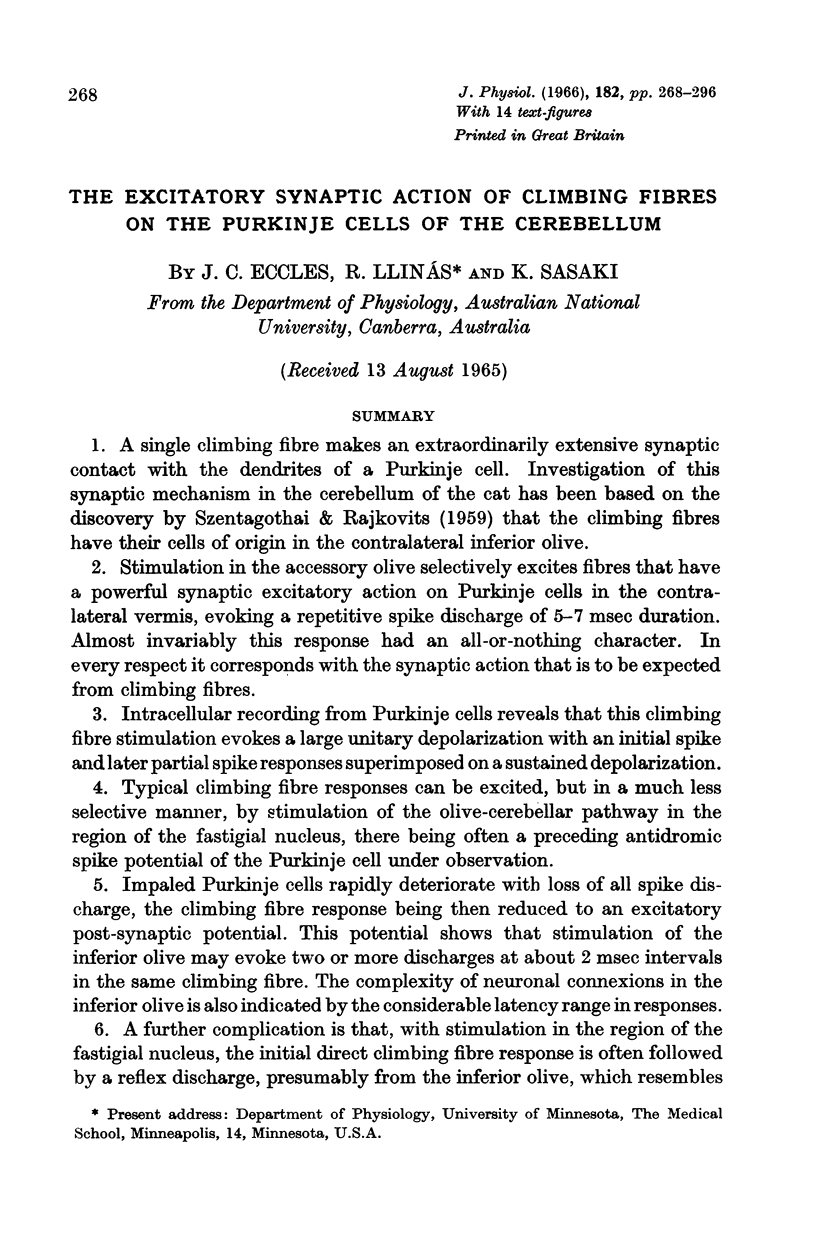
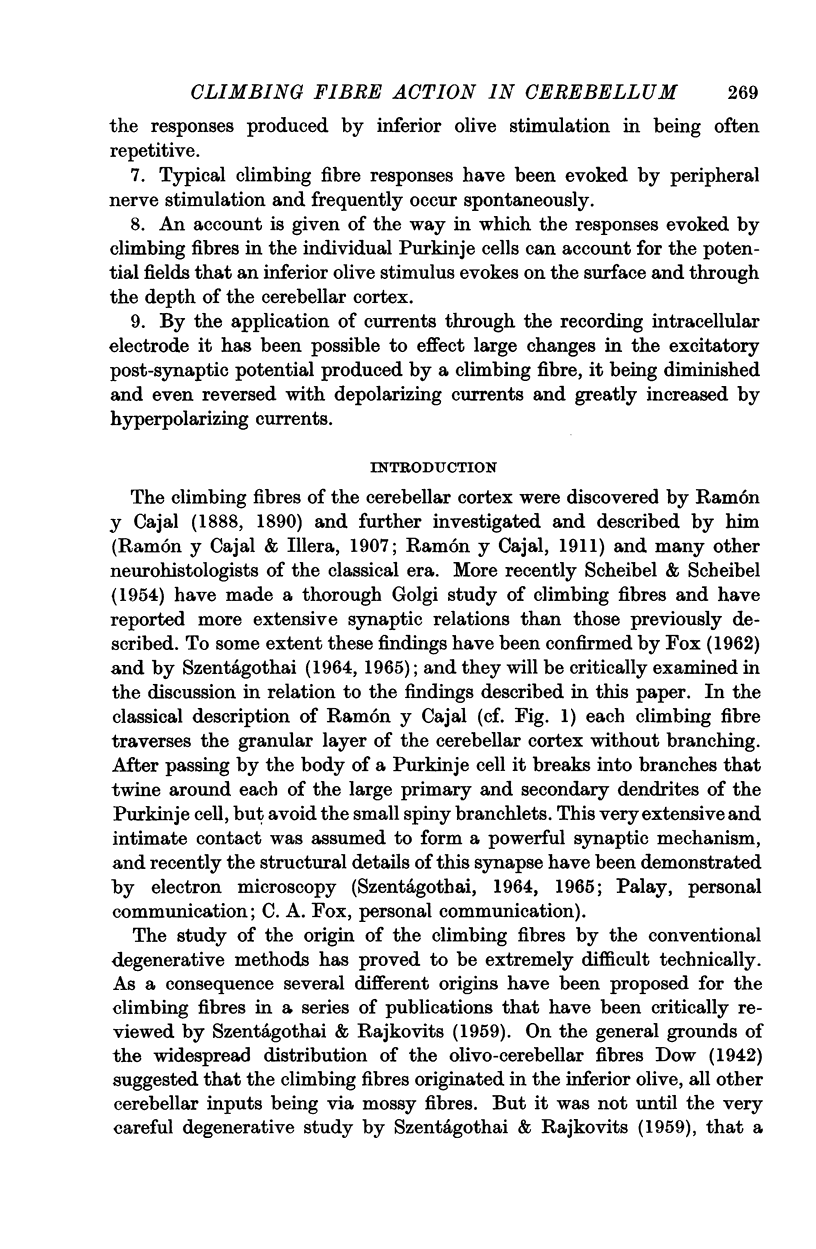
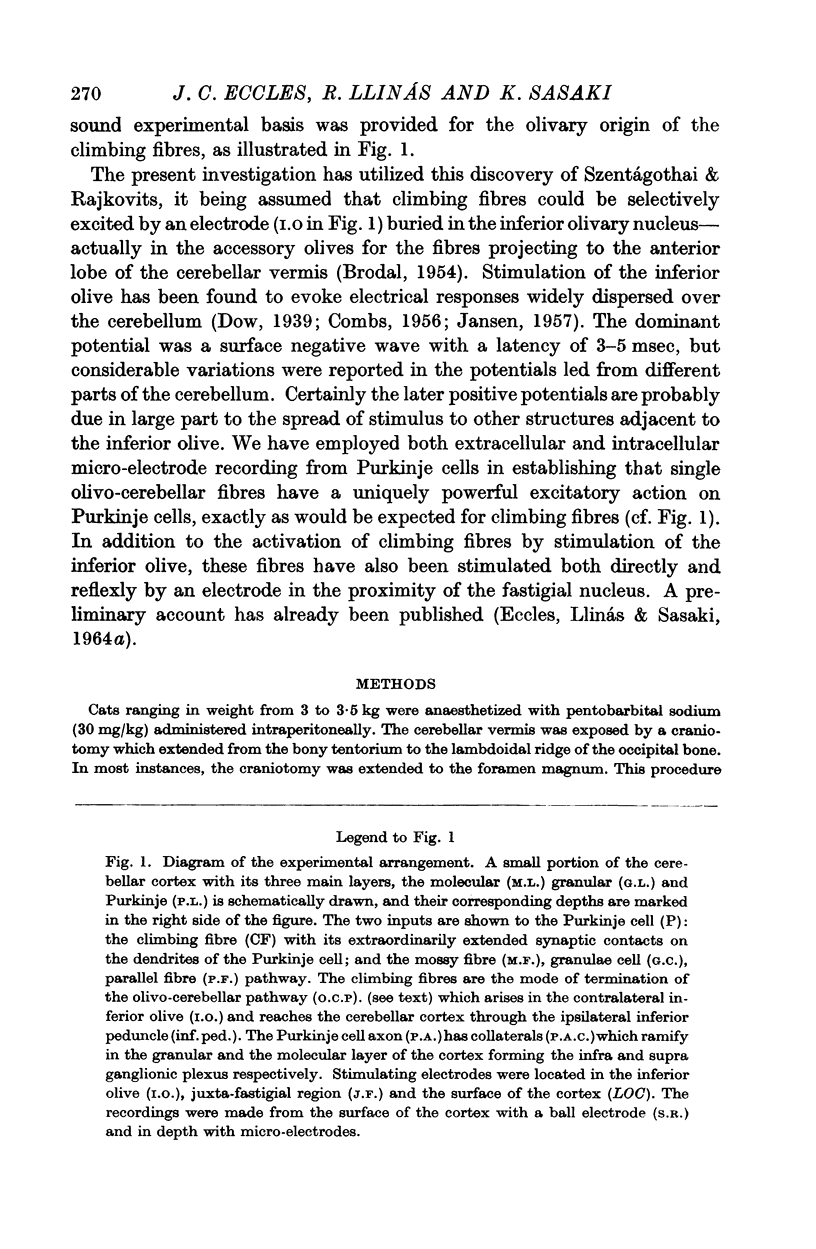
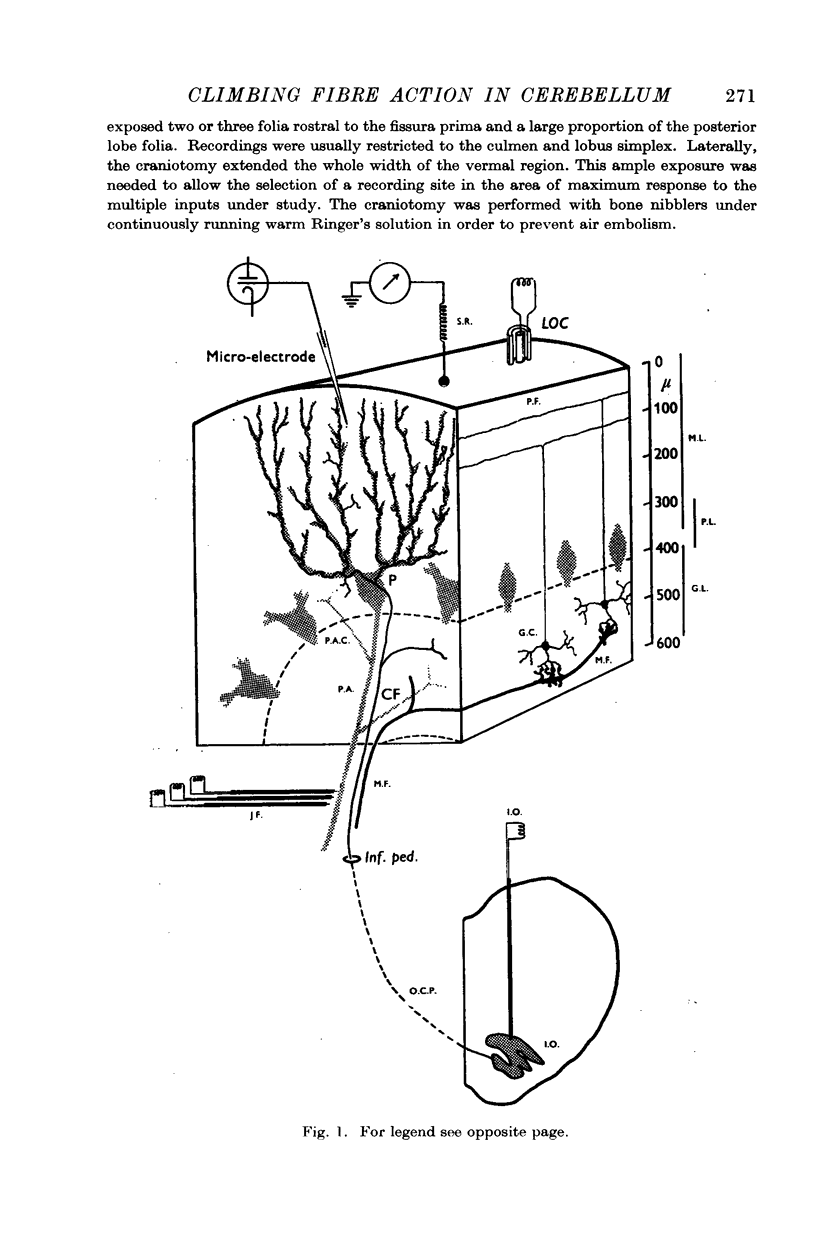
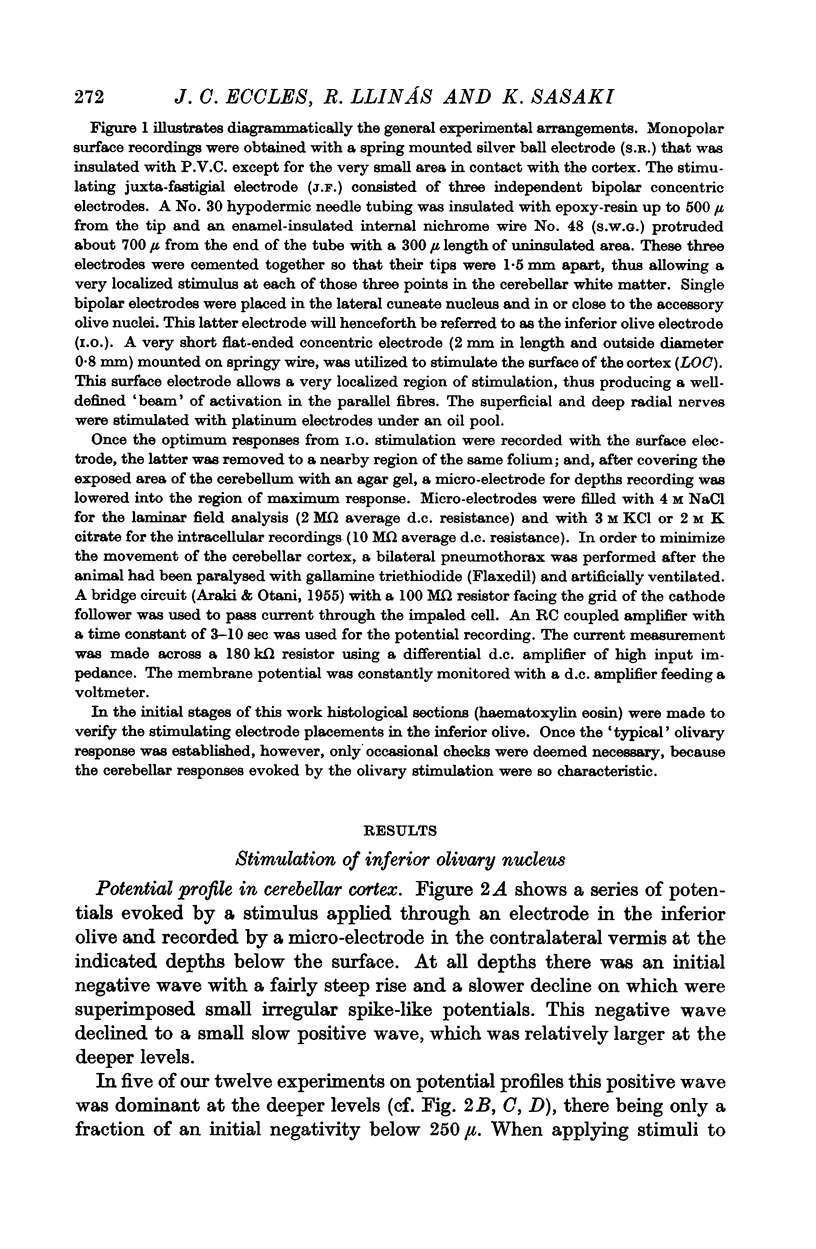
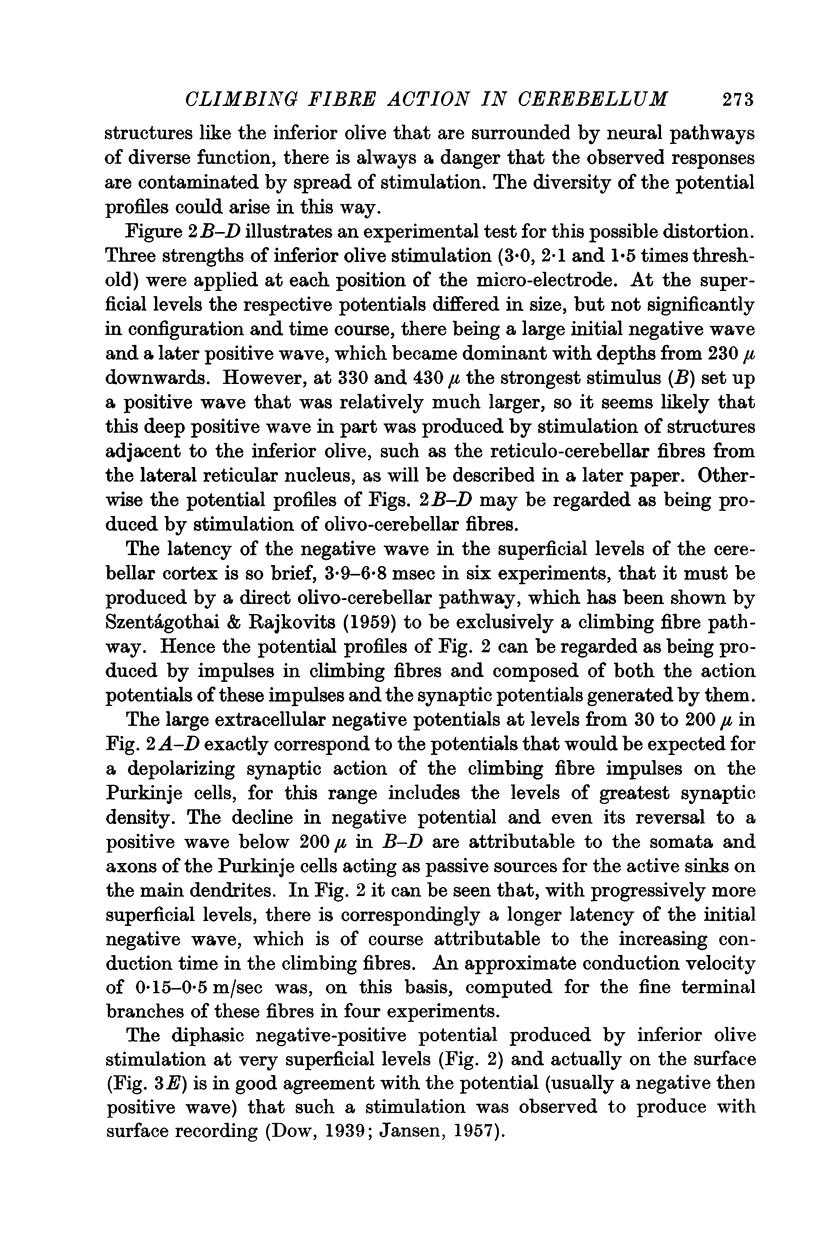
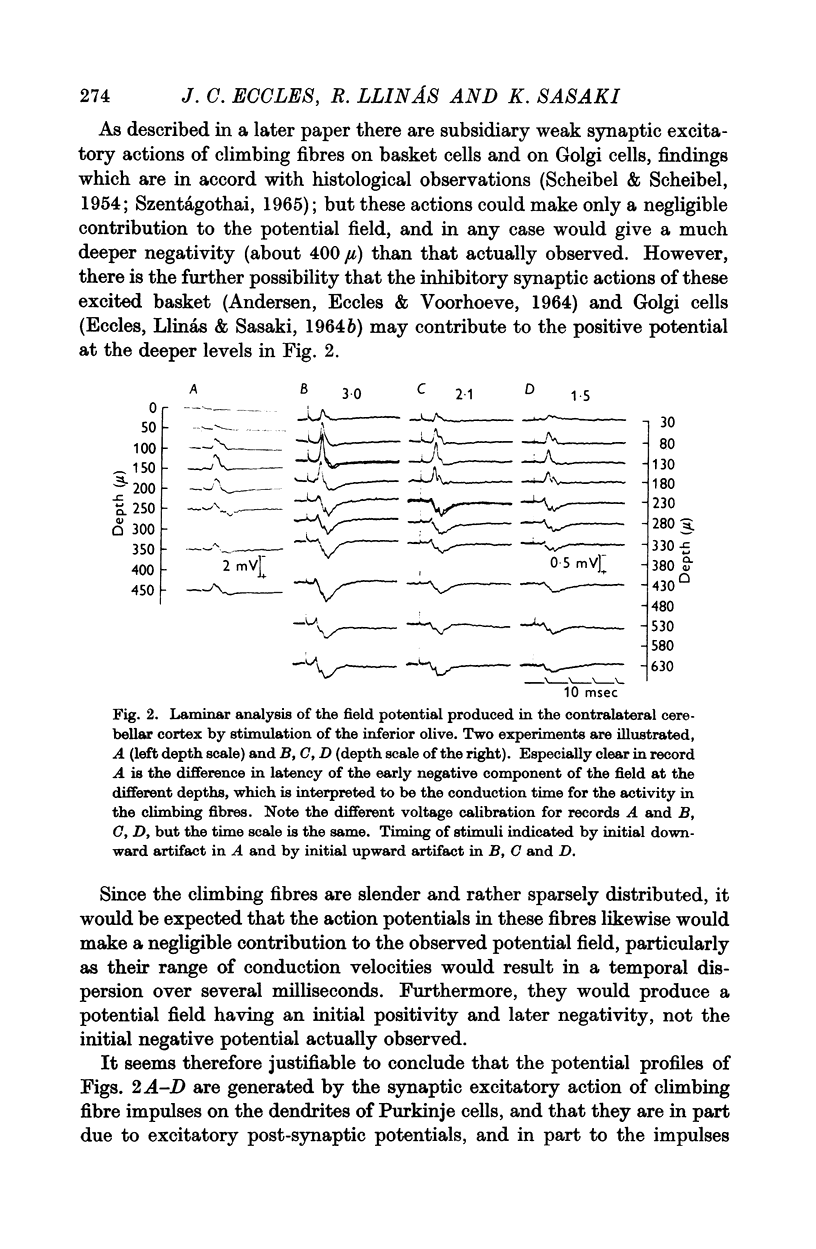
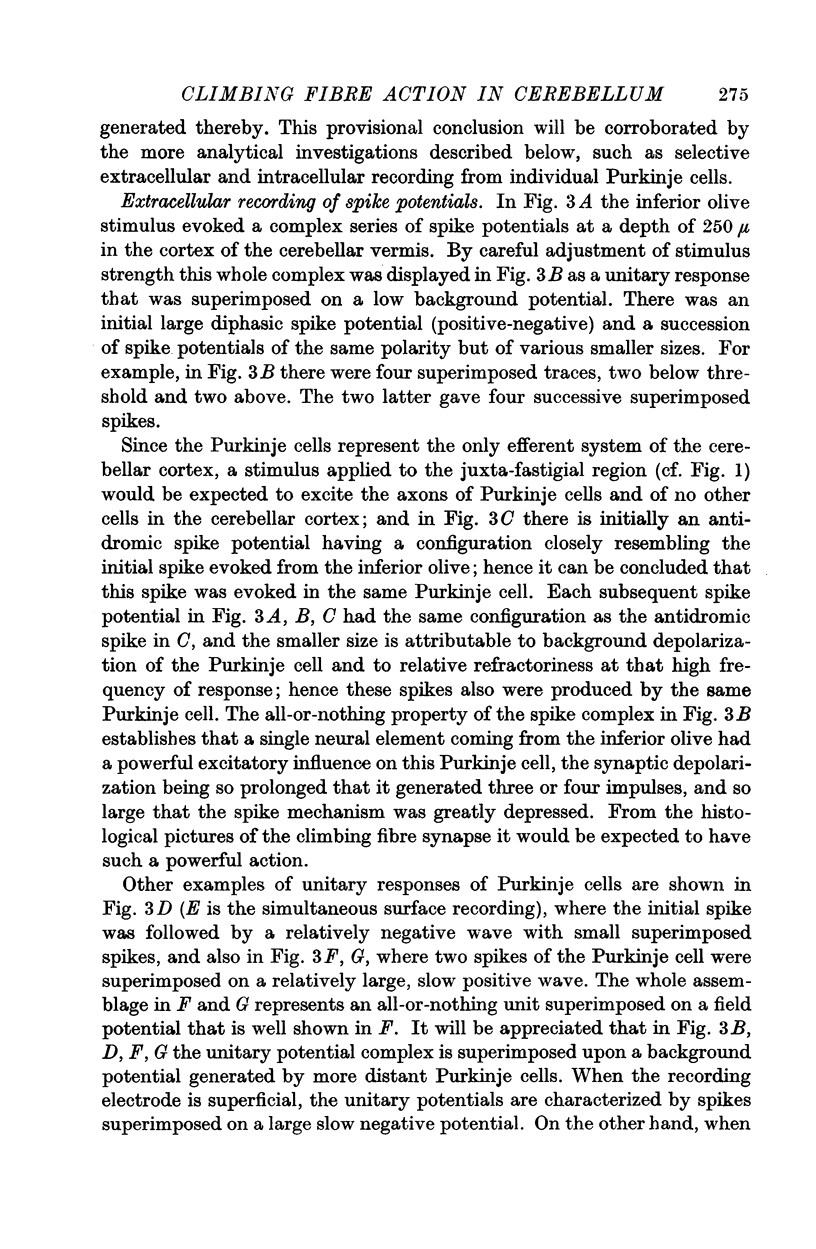
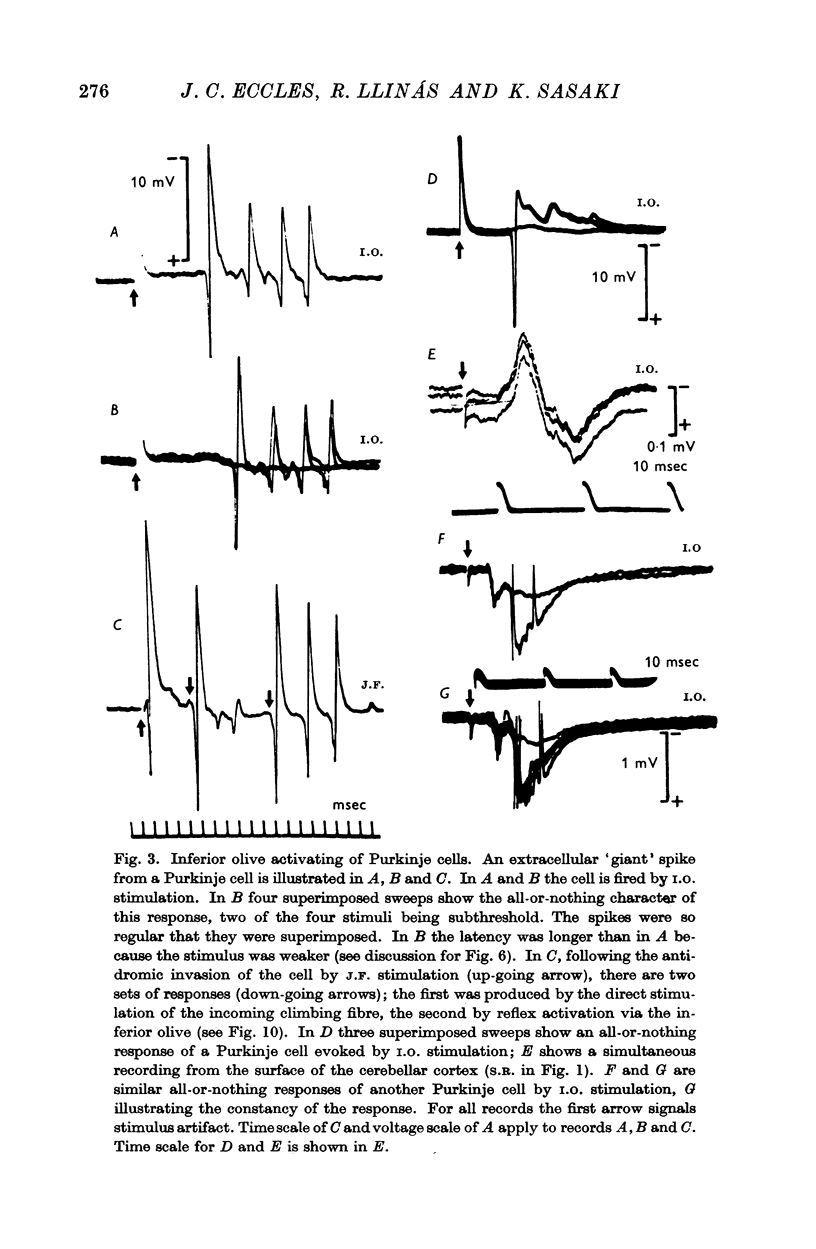
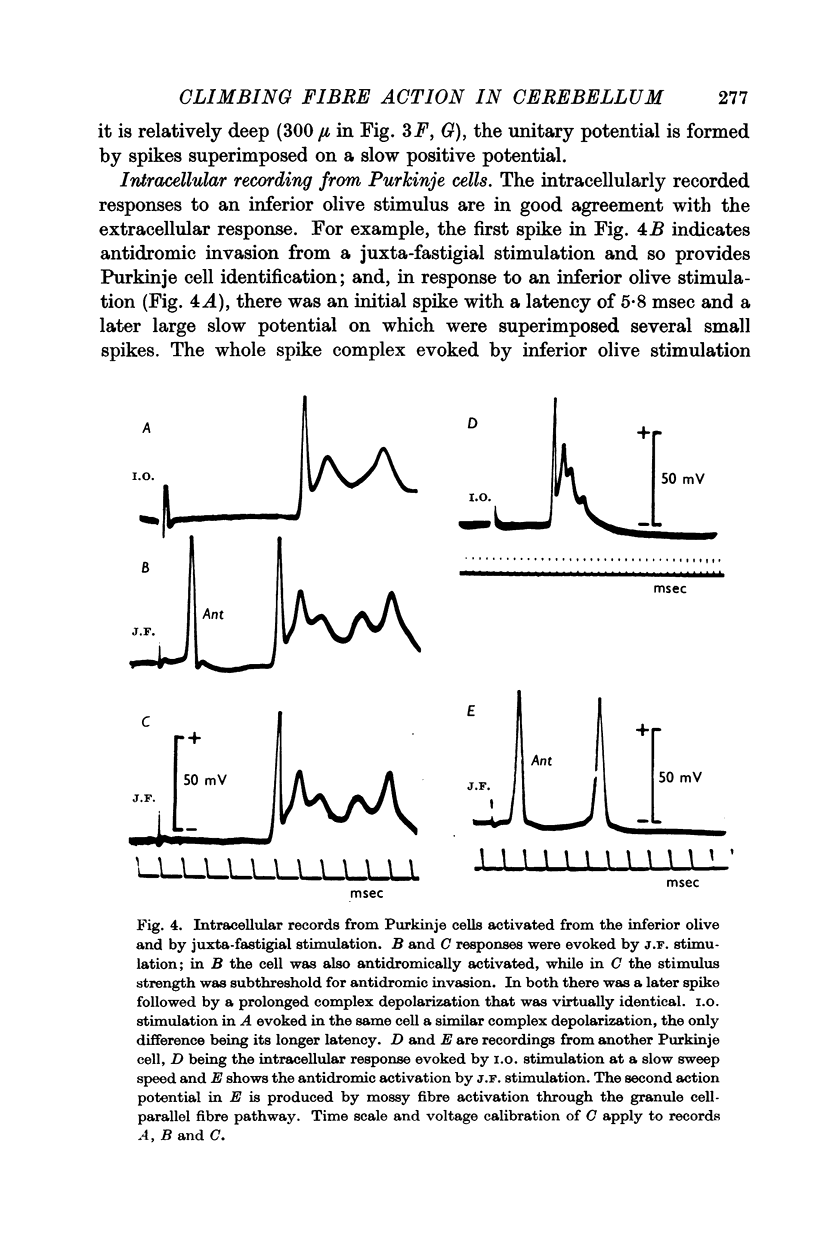
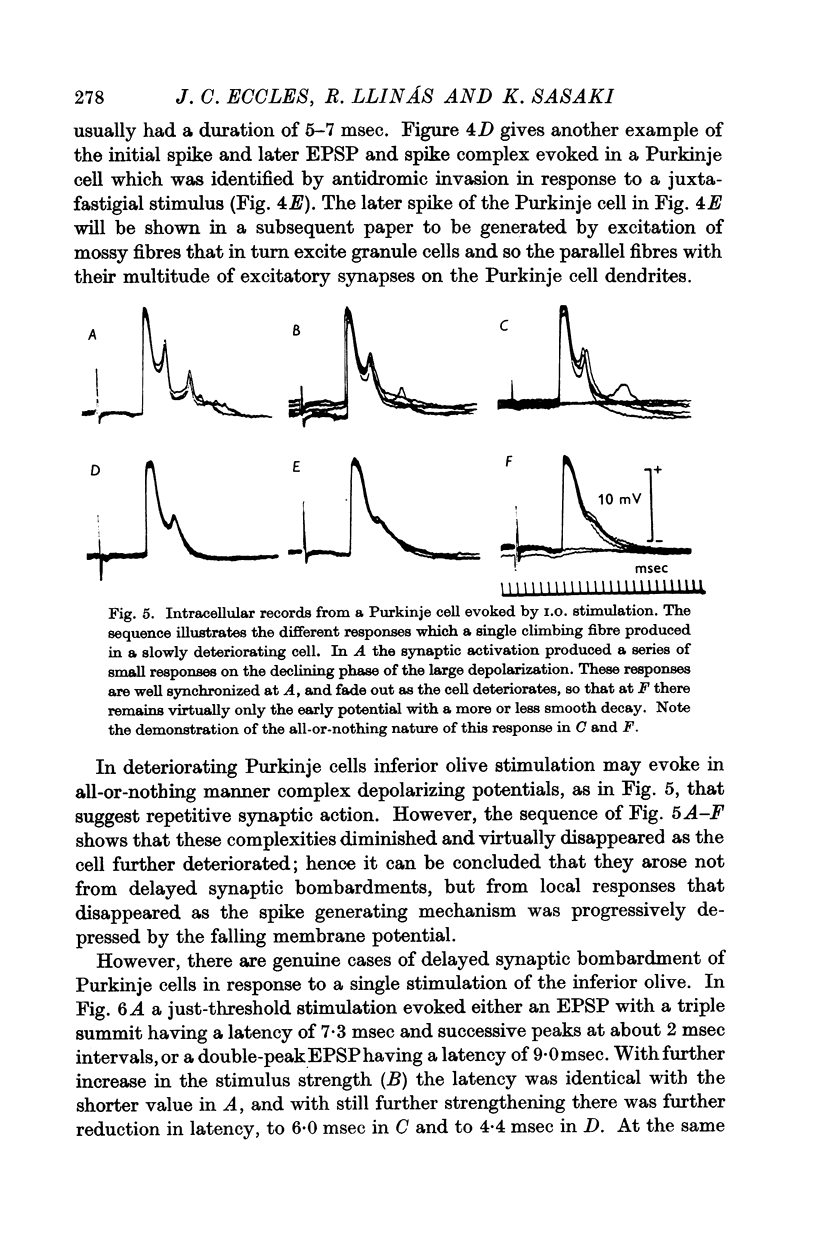
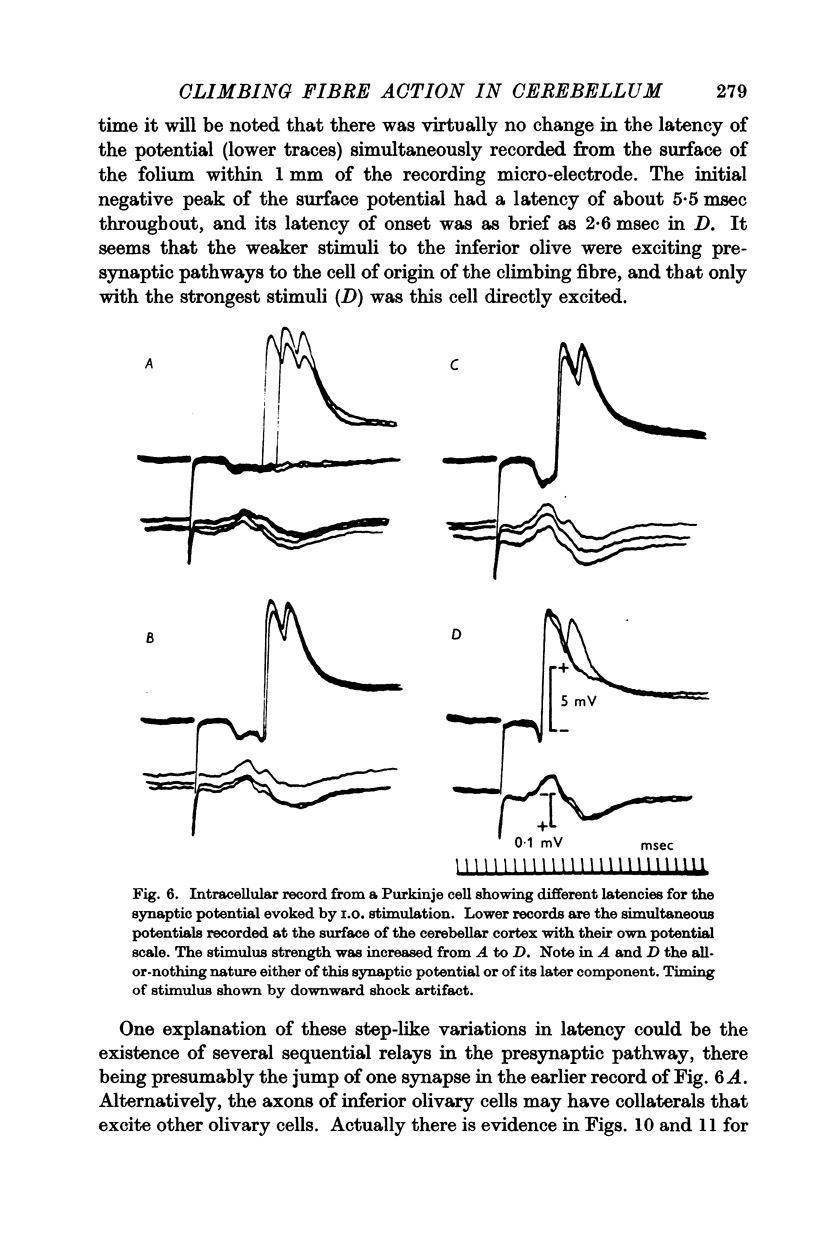
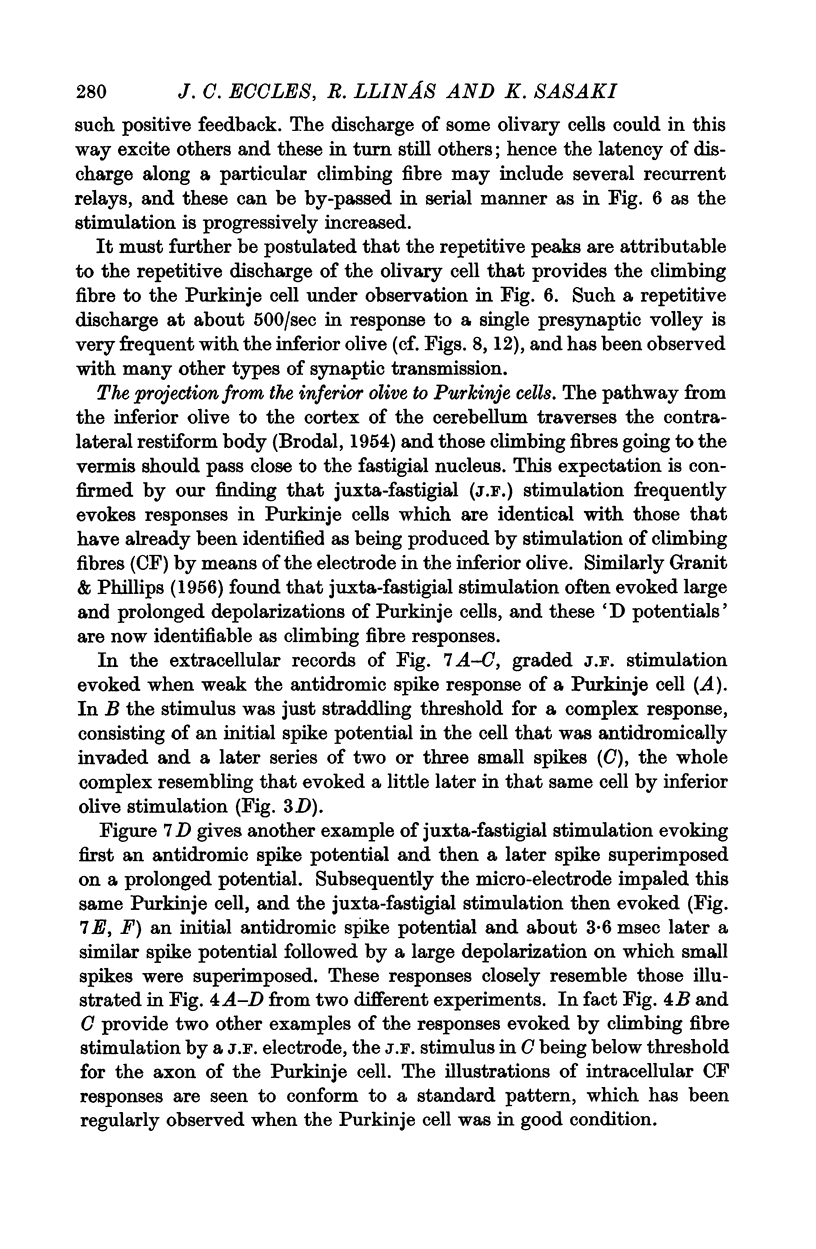
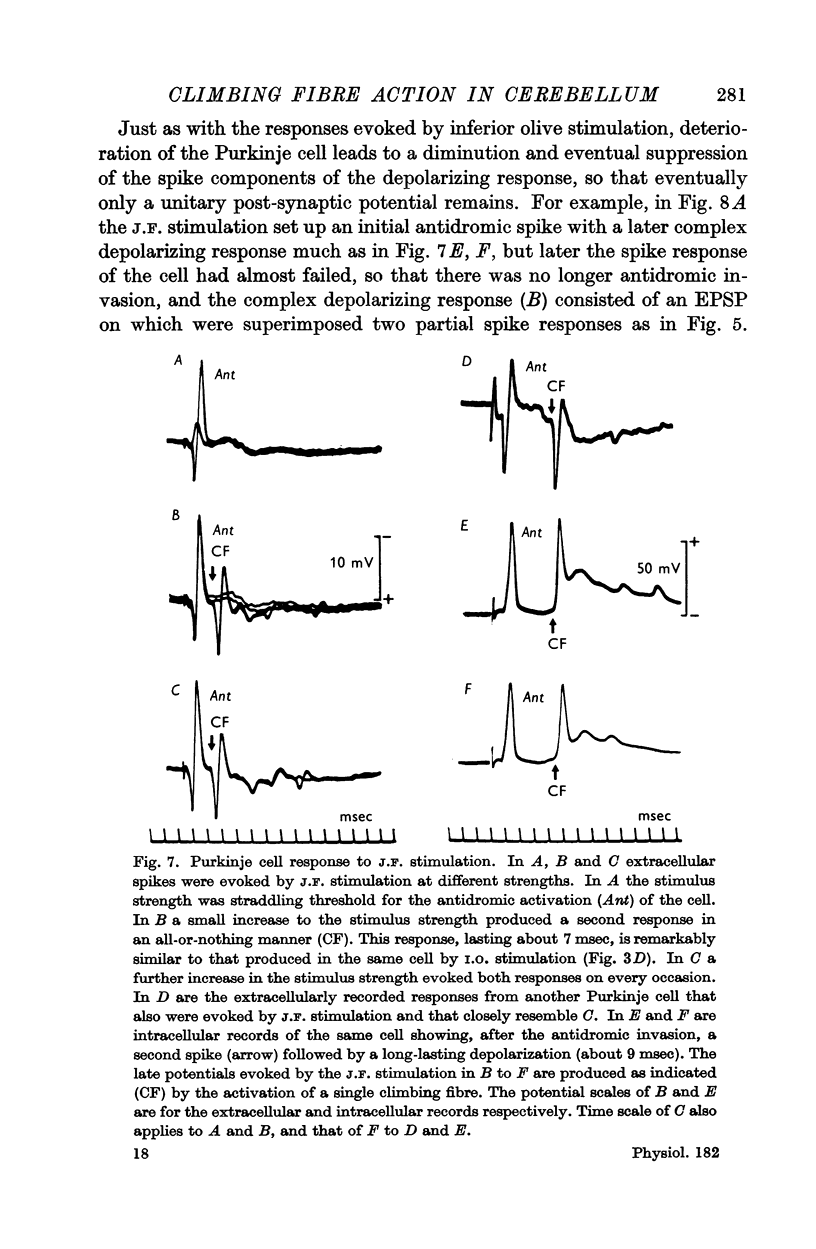
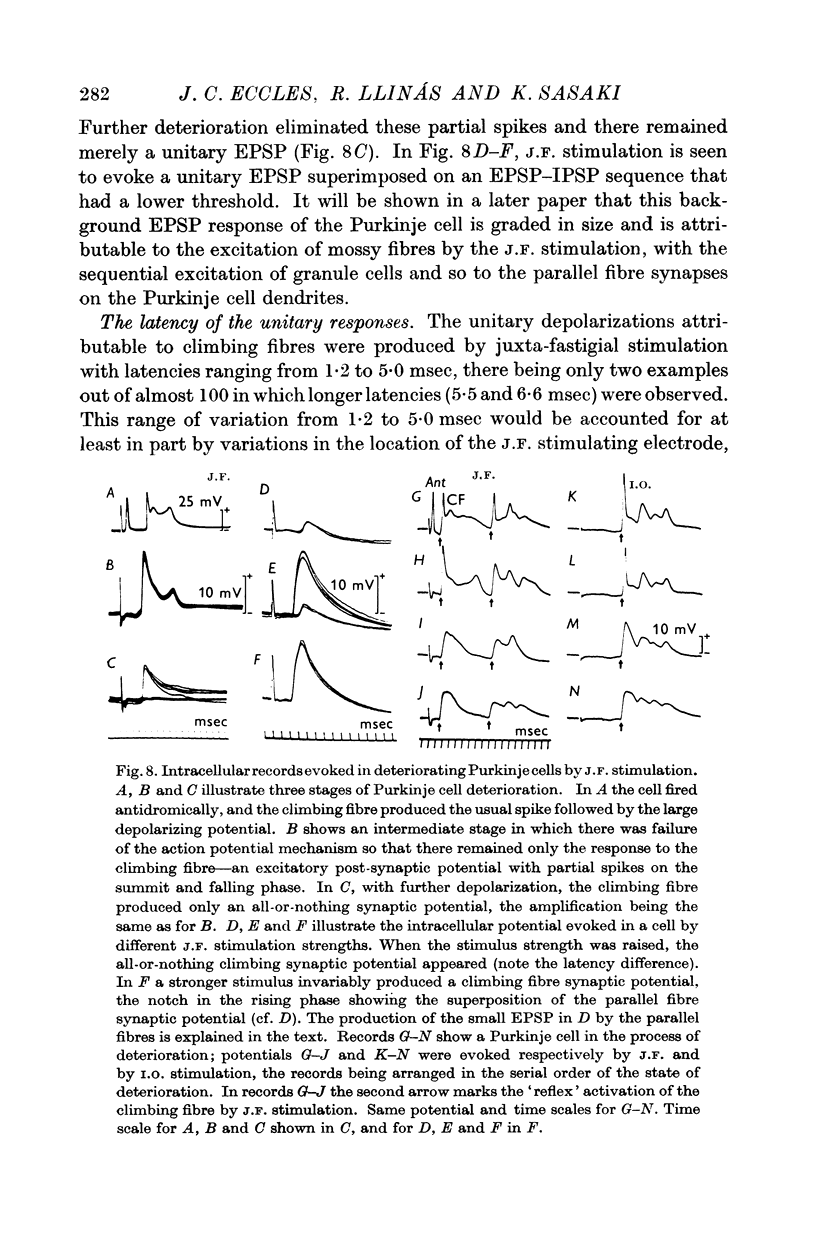
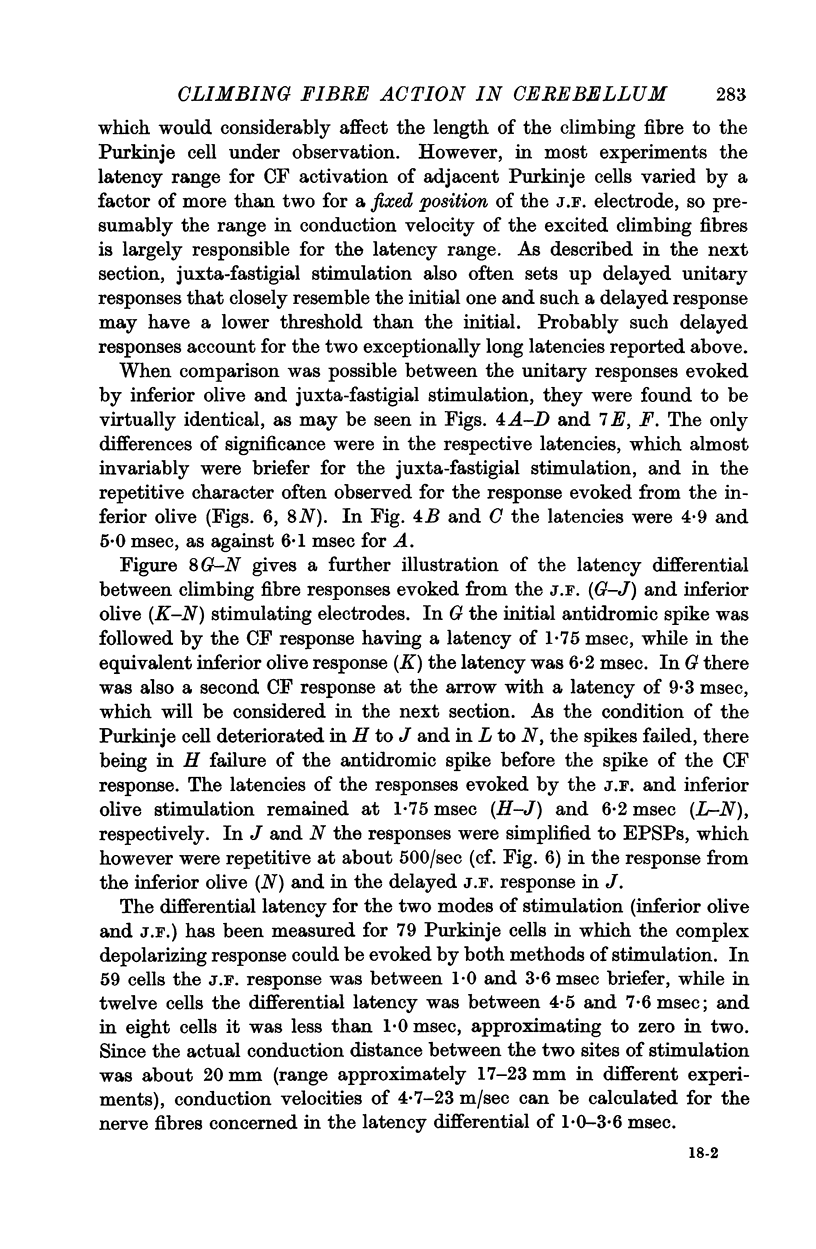
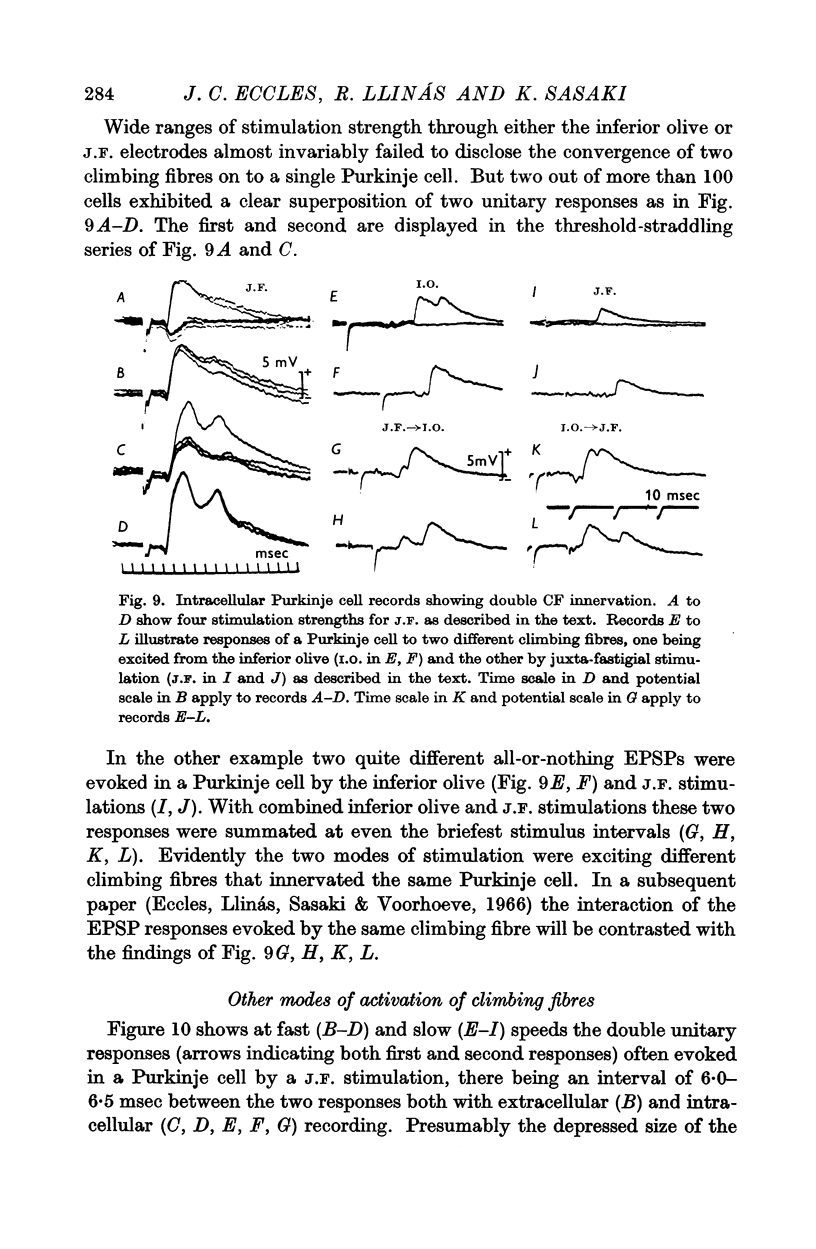
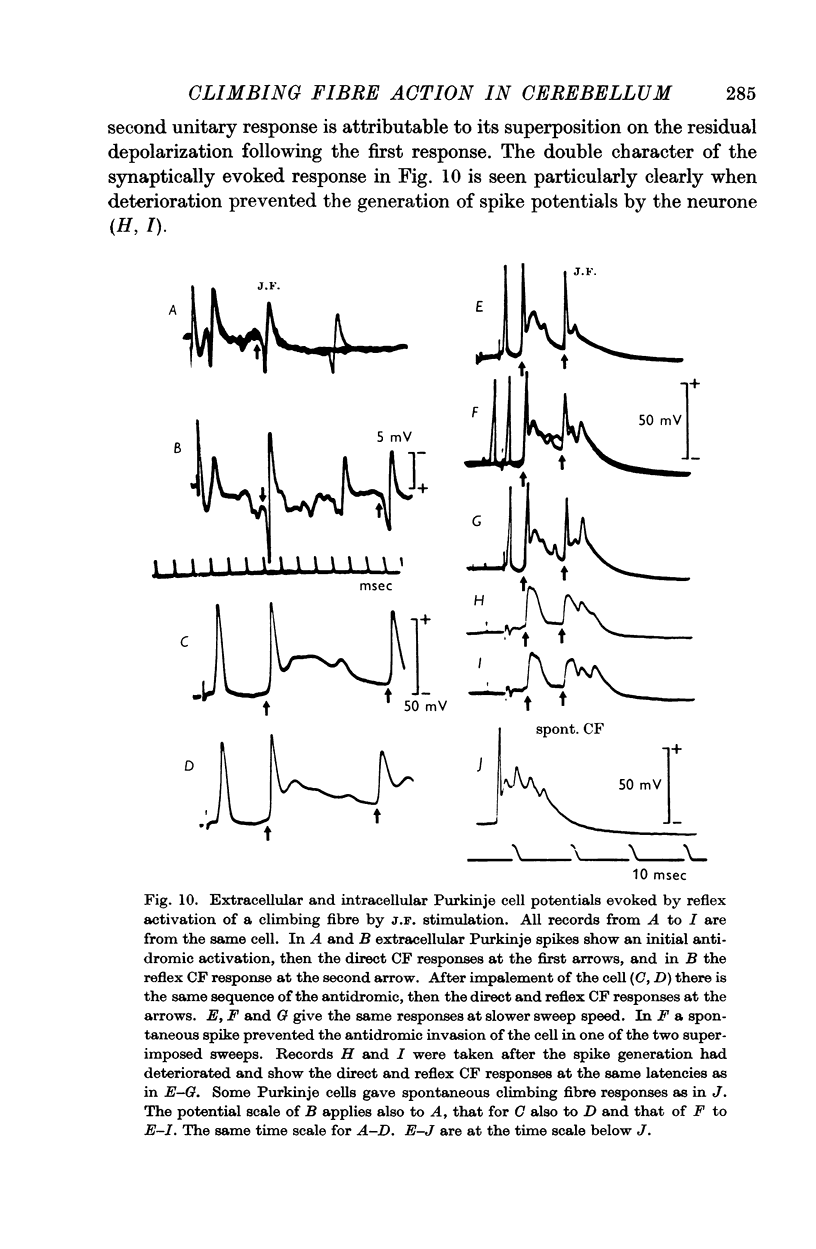
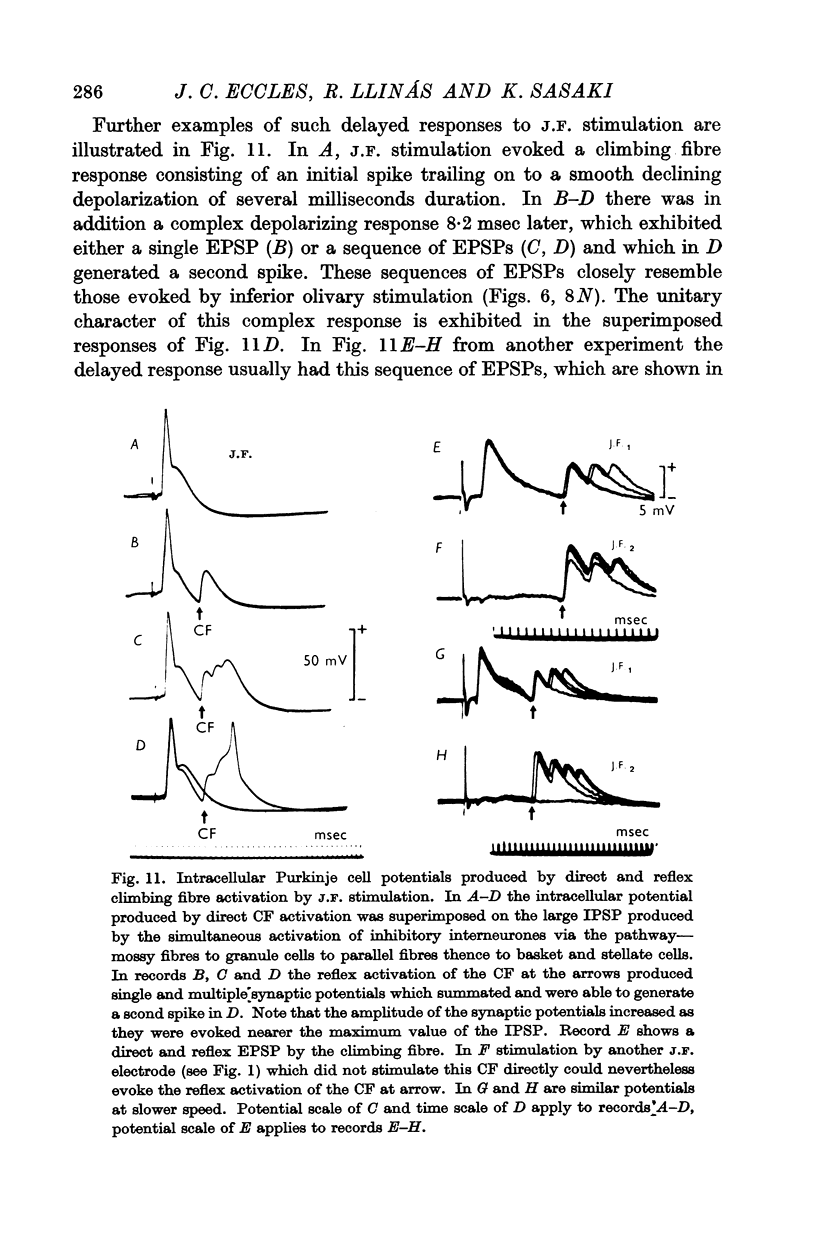
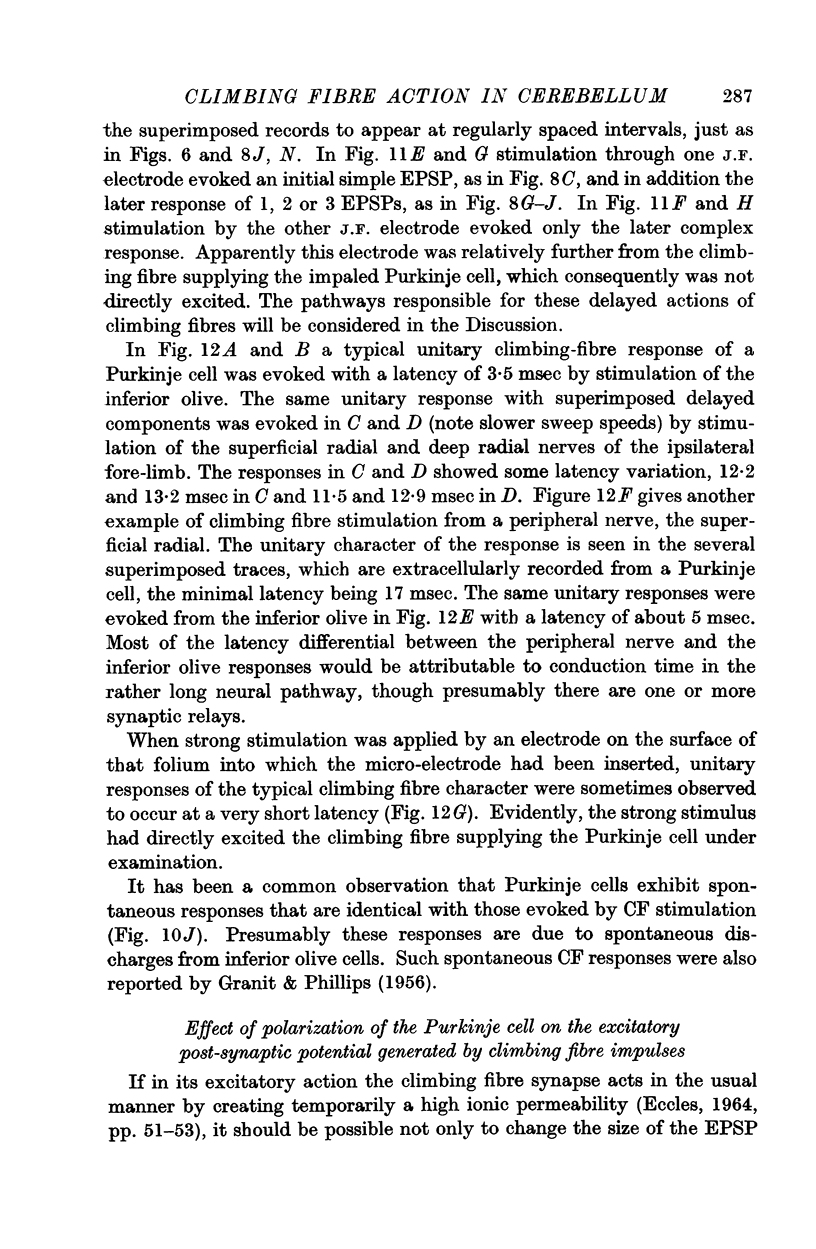
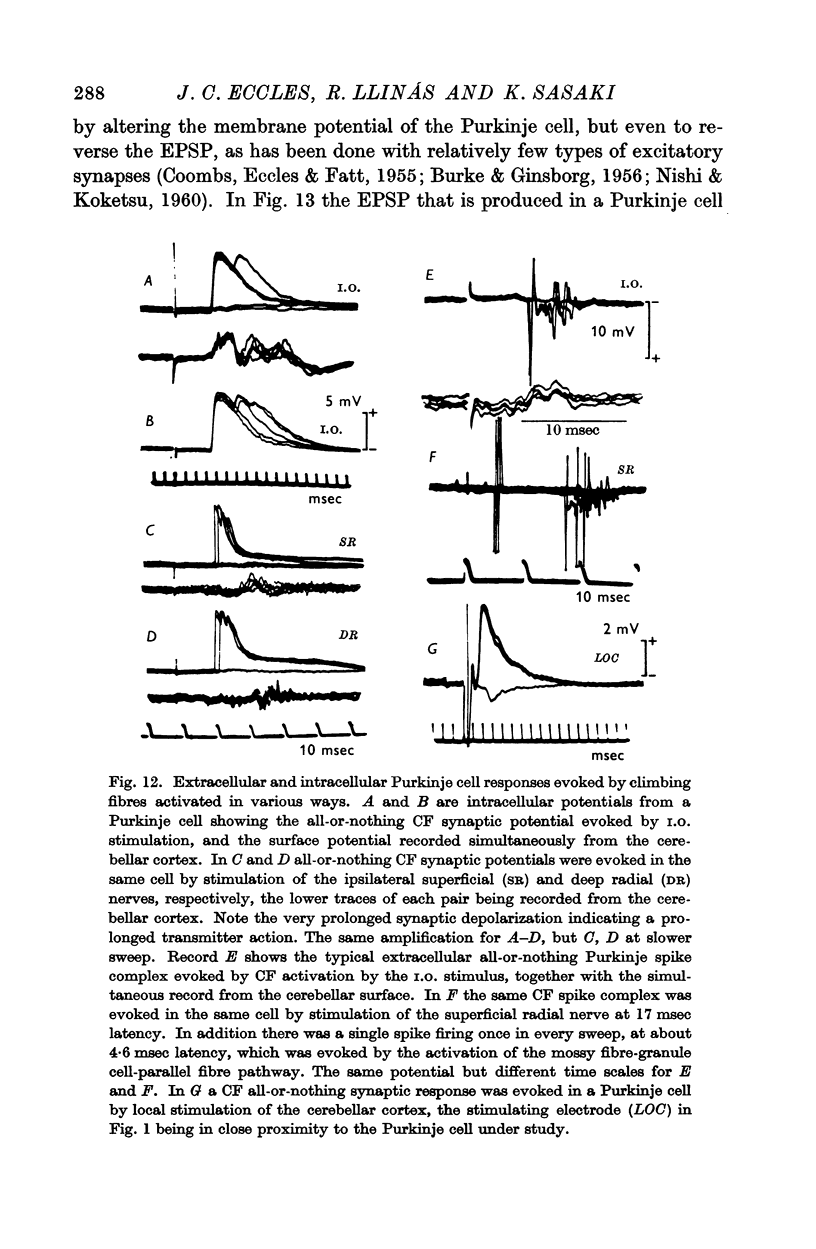
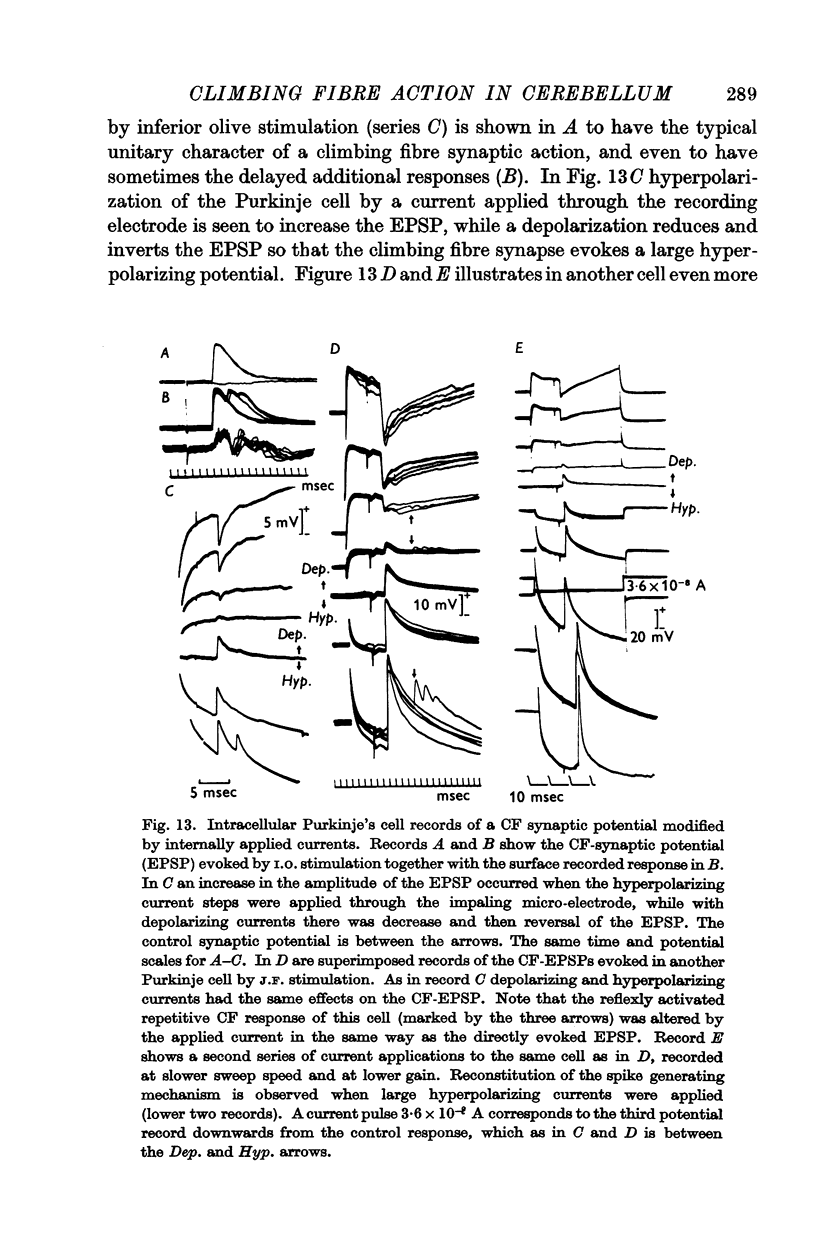
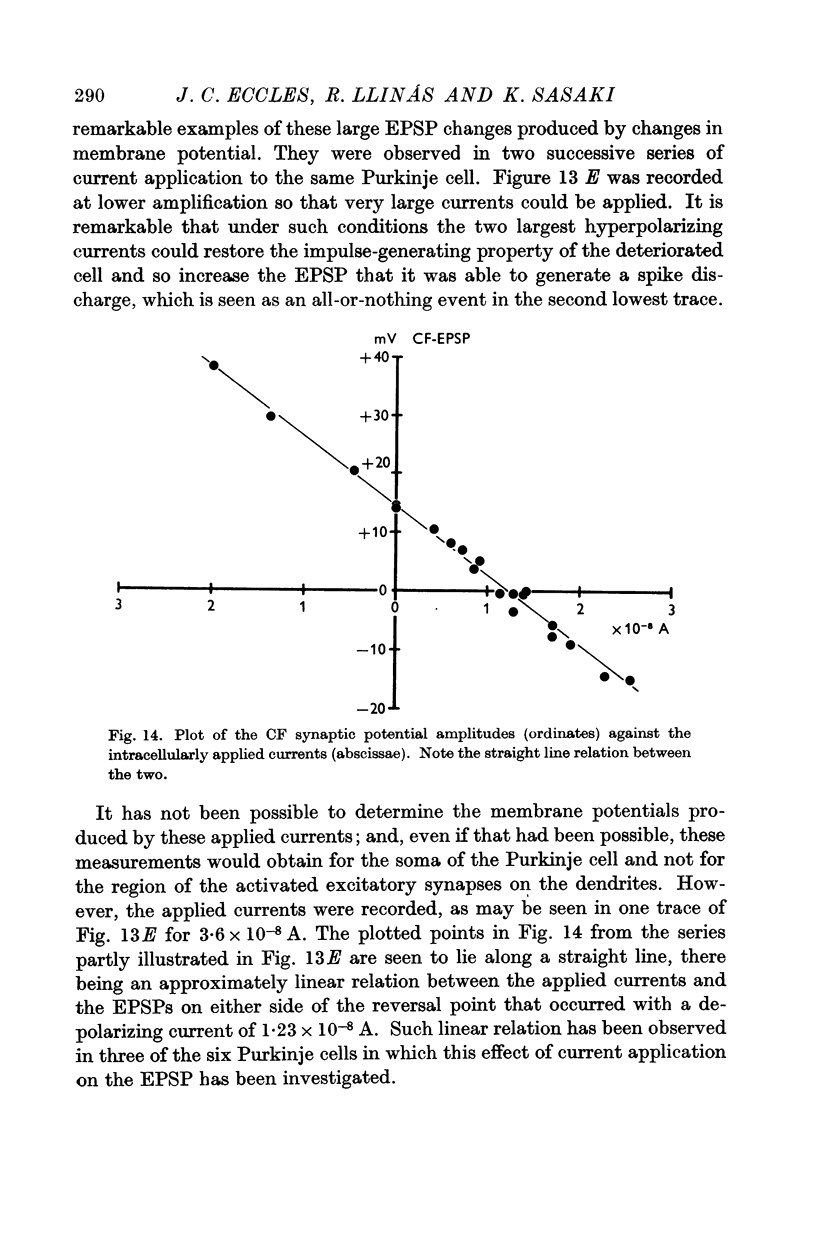
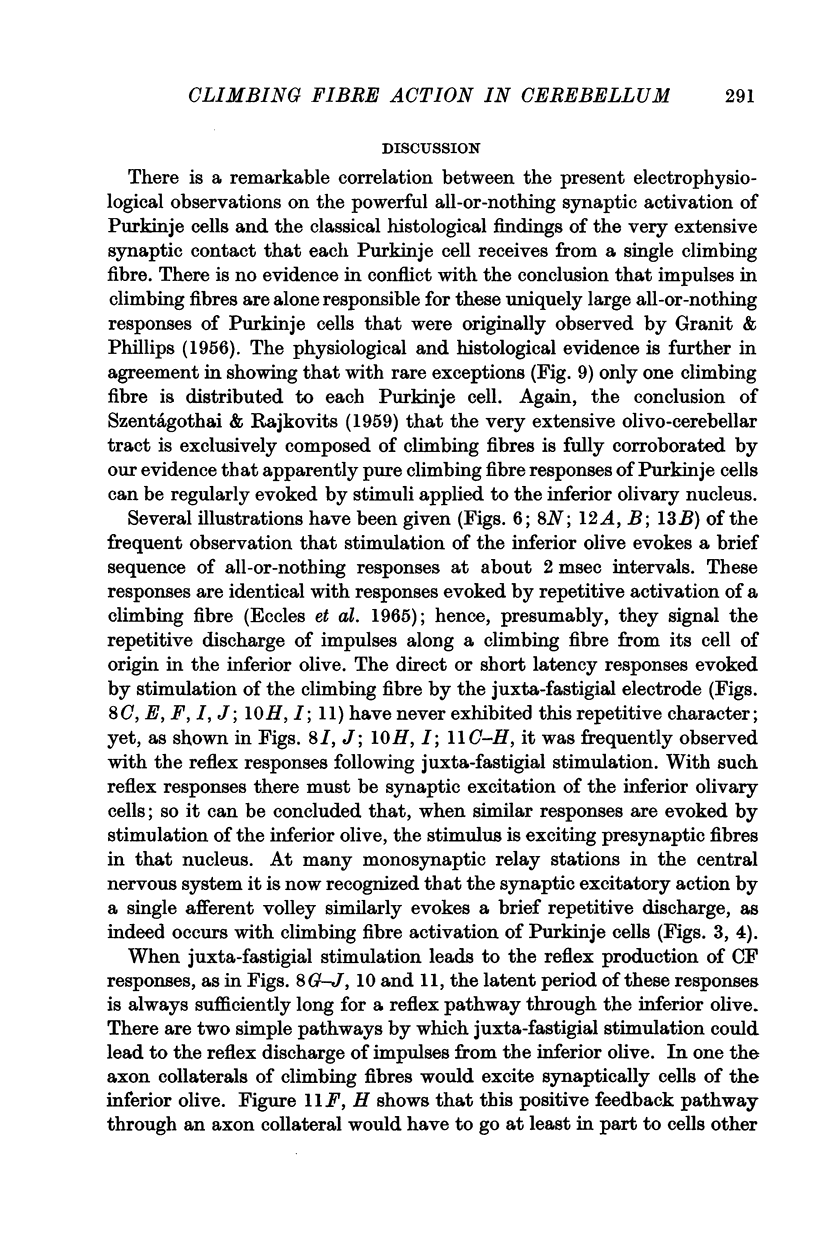
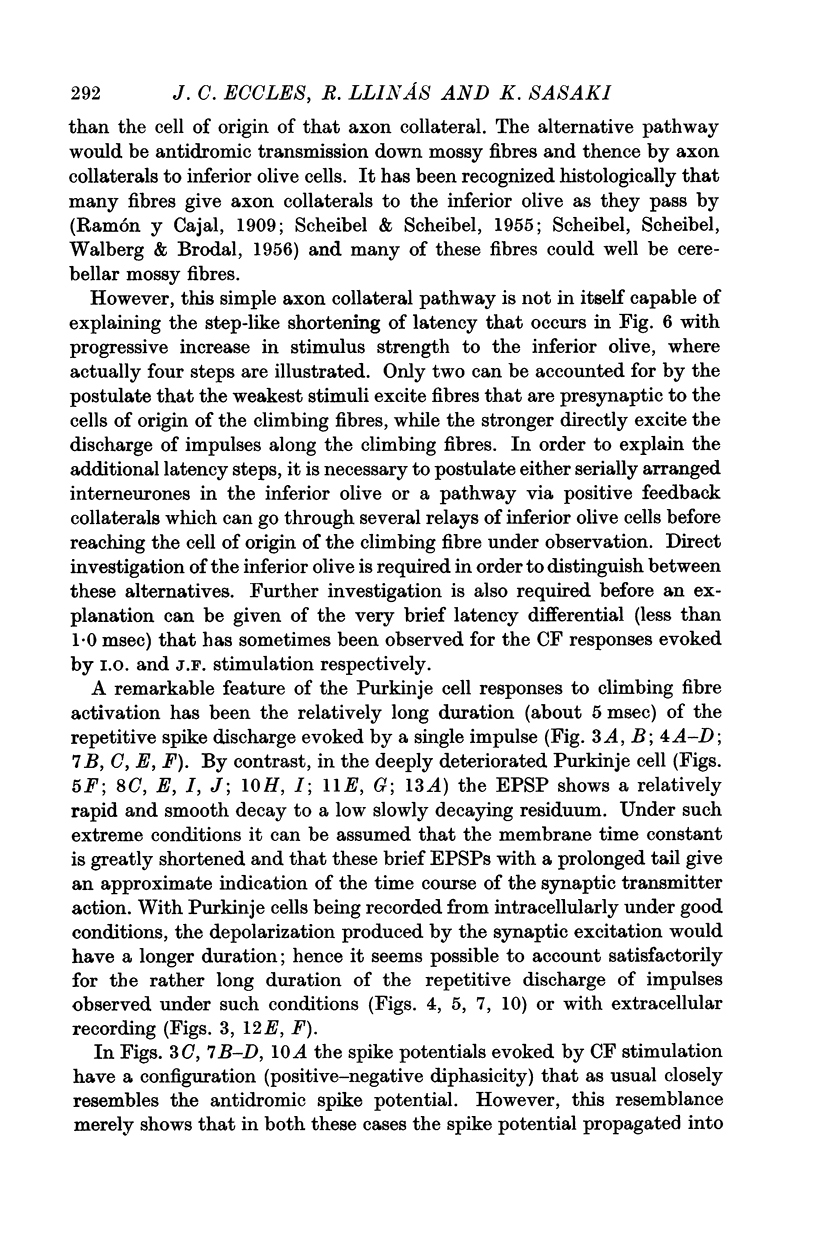
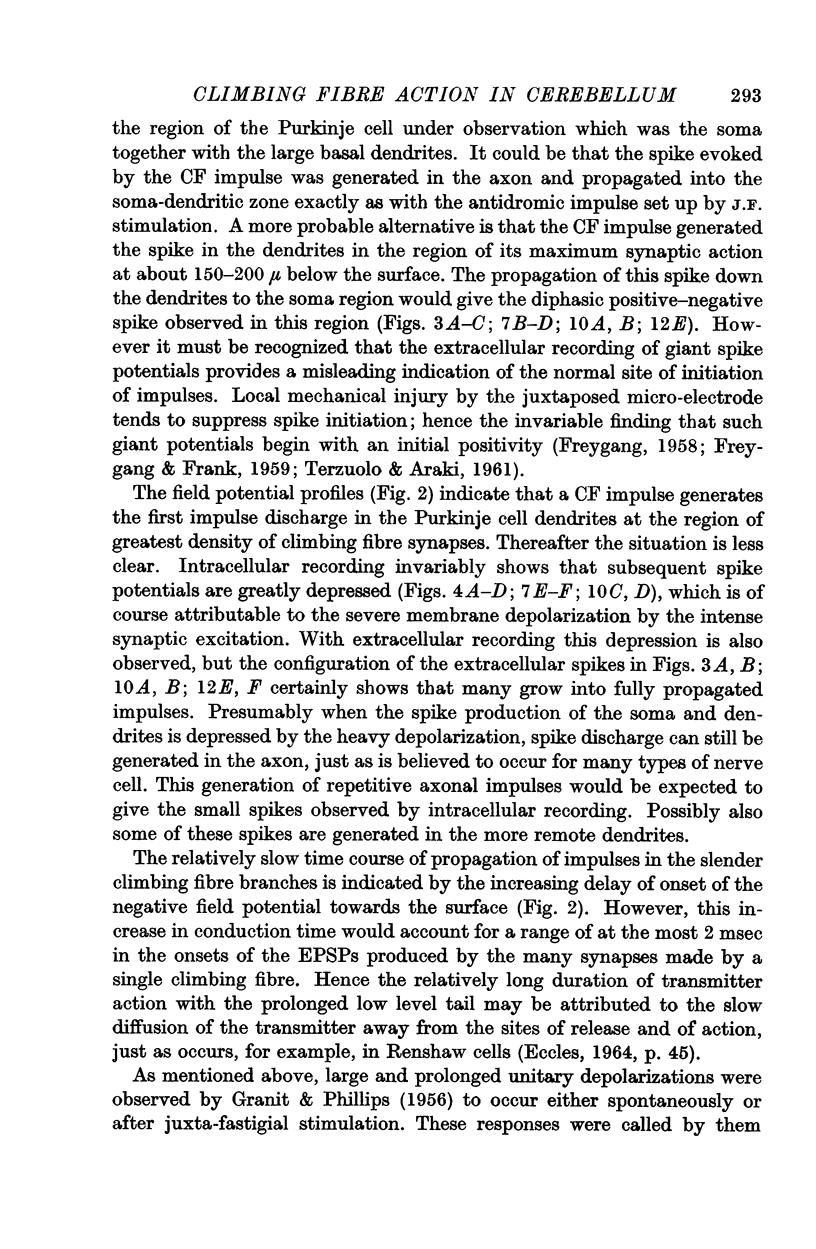
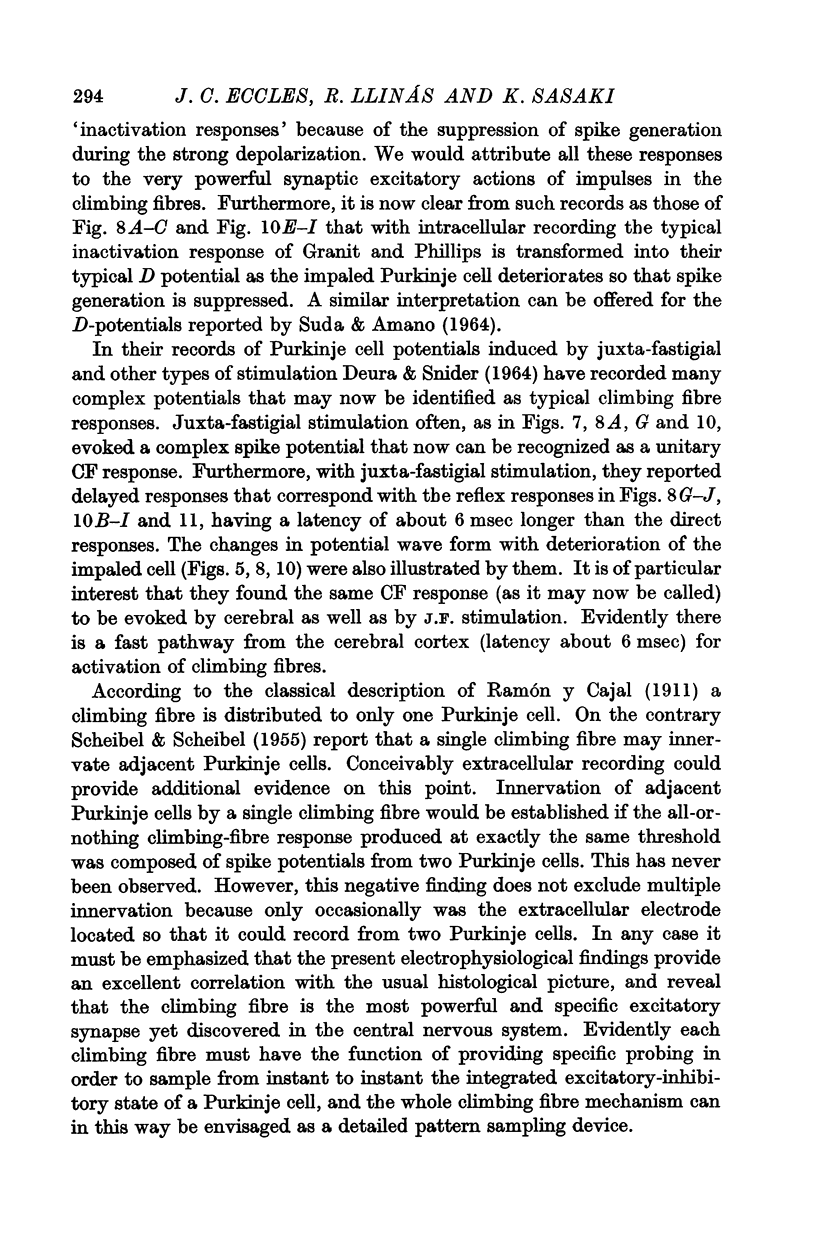
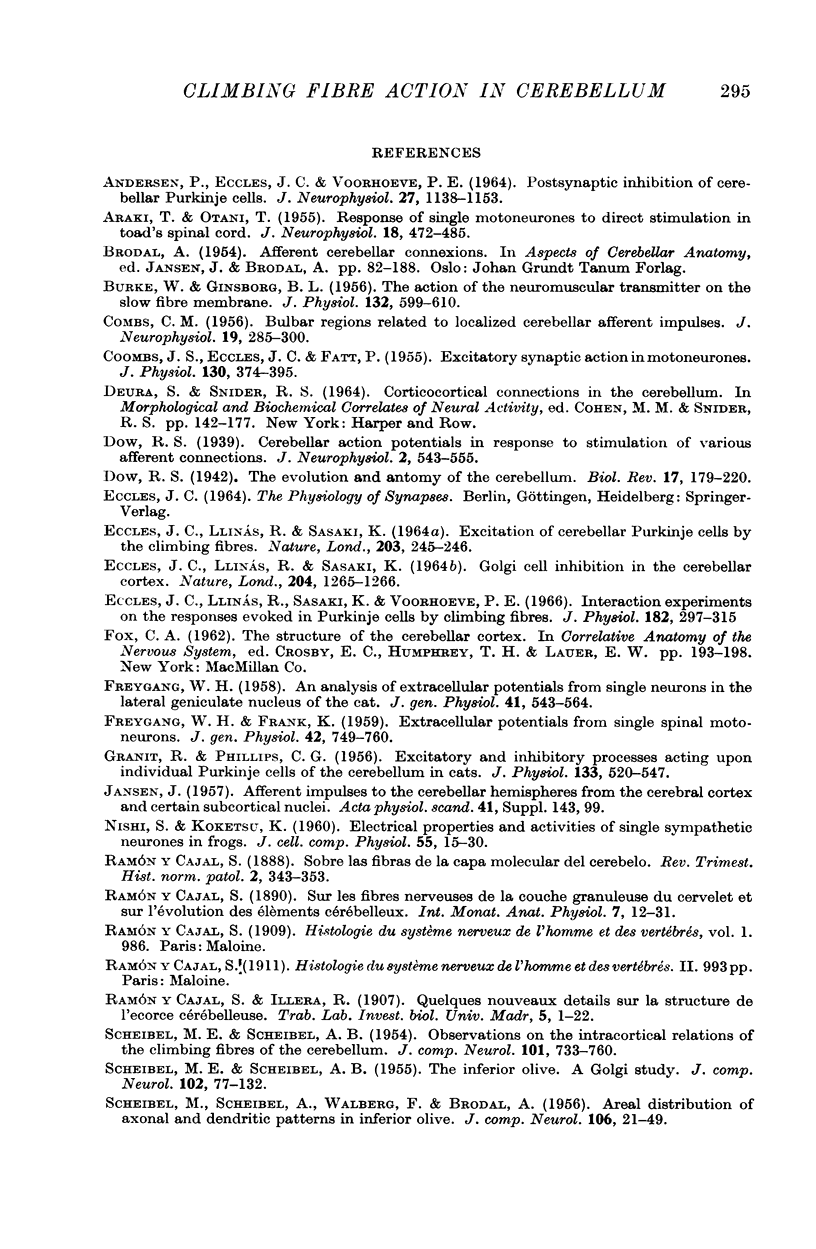
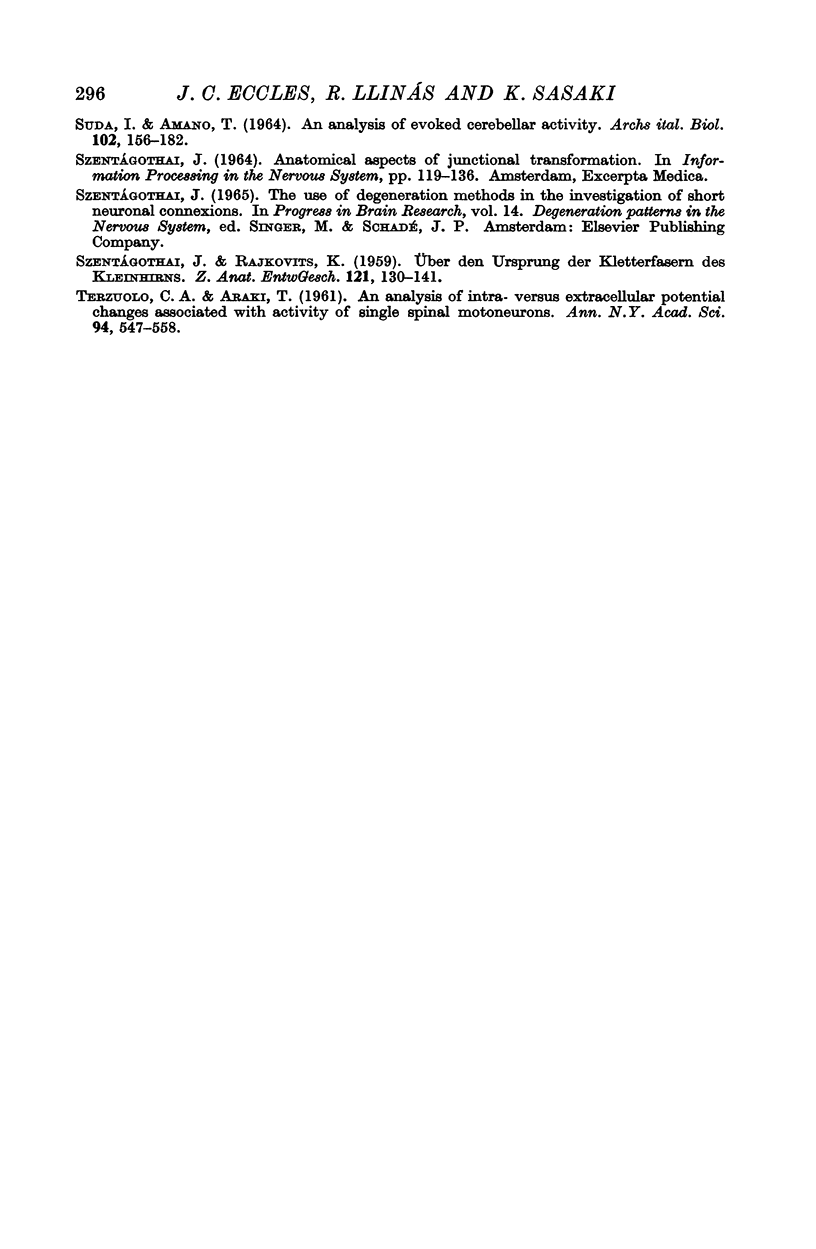
Selected References
These references are in PubMed. This may not be the complete list of references from this article.
- ANDERSEN P., ECCLES J. C., VOORHOEVE P. E. POSTSYNAPTIC INHIBITION OF CEREBELLAR PURKINJE CELLS. J Neurophysiol. 1964 Nov;27:1138–1153. doi: 10.1152/jn.1964.27.6.1138. [DOI] [PubMed] [Google Scholar]
- ARAKI T., OTANI T. Response of single motoneurons to direct stimulation in toad's spinal cord. J Neurophysiol. 1955 Sep;18(5):472–485. doi: 10.1152/jn.1955.18.5.472. [DOI] [PubMed] [Google Scholar]
- BRODAL A., SCHEIBEL A., SCHEIBEL M., WALBERG F. Areal distribution of axonal and dendritic patterns in inferior olive. J Comp Neurol. 1956 Nov;106(1):21–49. doi: 10.1002/cne.901060103. [DOI] [PubMed] [Google Scholar]
- BURKE W., GINSBORG B. L. The action of the neuromuscular transmitter on the slow fibre membrane. J Physiol. 1956 Jun 28;132(3):599–610. doi: 10.1113/jphysiol.1956.sp005552. [DOI] [PMC free article] [PubMed] [Google Scholar]
- COMBS C. M. Bulbar regions related to localized cerebellar afferent impulses. J Neurophysiol. 1956 Jul;19(4):285–300. doi: 10.1152/jn.1956.19.4.285. [DOI] [PubMed] [Google Scholar]
- COOMBS J. S., ECCLES J. C., FATT P. Excitatory synaptic action in motoneurones. J Physiol. 1955 Nov 28;130(2):374–395. doi: 10.1113/jphysiol.1955.sp005413. [DOI] [PMC free article] [PubMed] [Google Scholar]
- ECCLES J., LLINAS R., SASAKI K. EXCITATION OF CEREBELLAR PURKINJE CELLS BY THE CLIMBING FIBRES. Nature. 1964 Jul 18;203:245–246. doi: 10.1038/203245a0. [DOI] [PubMed] [Google Scholar]
- ECCLES J., LLINAS R., SASAKI K. GOLGI CELL INHIBITION IN THE CEREBELLAR CORTEX. Nature. 1964 Dec 26;204:1265–1266. doi: 10.1038/2041265a0. [DOI] [PubMed] [Google Scholar]
- Eccles J. C., Llinás R., Sasaki K., Voorhoeve P. E. Interaction experiments on the responses evoked in Purkinje cells by climbing fibres. J Physiol. 1966 Jan;182(2):297–315. doi: 10.1113/jphysiol.1966.sp007825. [DOI] [PMC free article] [PubMed] [Google Scholar]
- FREYGANG W. H., Jr An analysis of extracellular potentials from single neurons in the lateral geniculate nucleus of the cat. J Gen Physiol. 1958 Jan 20;41(3):543–564. doi: 10.1085/jgp.41.3.543. [DOI] [PMC free article] [PubMed] [Google Scholar]
- FREYGANG W. H., Jr, FRANK K. Extracellular potentials from single spinal motoneurons. J Gen Physiol. 1959 Mar 20;42(4):749–760. doi: 10.1085/jgp.42.4.749. [DOI] [PMC free article] [PubMed] [Google Scholar]
- GRANIT R., PHILLIPS C. G. Excitatory and inhibitory processes acting upon individual Purkinje cells of the cerebellum in cats. J Physiol. 1956 Sep 27;133(3):520–547. doi: 10.1113/jphysiol.1956.sp005606. [DOI] [PMC free article] [PubMed] [Google Scholar]
- NISHI S., KOKETSU K. Electrical properties and activities of single sympathetic neurons in frogs. J Cell Comp Physiol. 1960 Feb;55:15–30. doi: 10.1002/jcp.1030550104. [DOI] [PubMed] [Google Scholar]
- SCHEIBEL M. E., SCHEIBEL A. B. Observations on the intracortical relations of the climbing fibers of the cerebellum; a Golgi study. J Comp Neurol. 1954 Dec;101(3):733–763. doi: 10.1002/cne.901010305. [DOI] [PubMed] [Google Scholar]
- SCHEIBEL M. E., SCHEIBEL A. B. The inferior olive; a Golgi study. J Comp Neurol. 1955 Feb;102(1):77–131. doi: 10.1002/cne.901020106. [DOI] [PubMed] [Google Scholar]
- SUDA I., AMANO T. AN ANALYSIS OF EVOKED CEREBELLAR ACTIVITY. Arch Ital Biol. 1964 Apr 18;102:156–182. [PubMed] [Google Scholar]
- TERZUOLO C. A., ARAKI T. An analysis of intra- versus extracellular potential changes associated with activity of single spinal motoneurons. Ann N Y Acad Sci. 1961 Sep 6;94:547–558. doi: 10.1111/j.1749-6632.1961.tb35558.x. [DOI] [PubMed] [Google Scholar]


